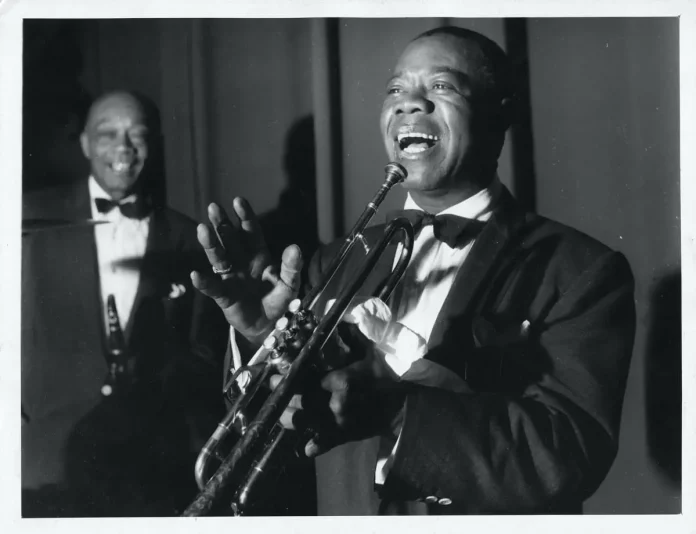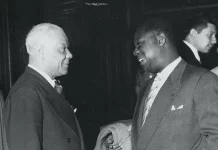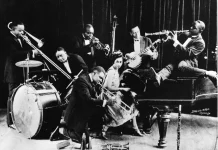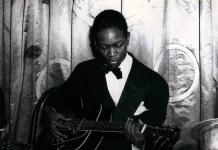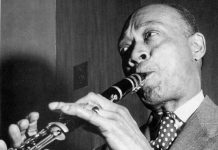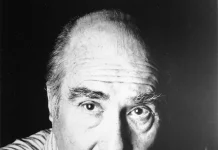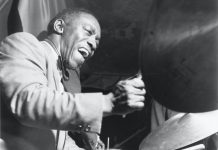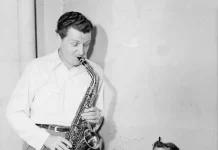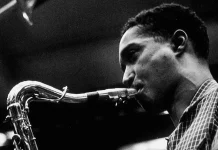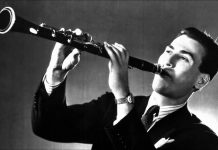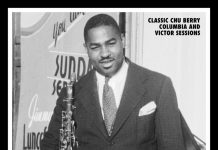Edmond Hall was far and away the finest of jazz musicians to join the All Stars. Unlike the majority of Louis’s sidemen, Ed improvised different solos every night, and didn’t depend on set routines.
The potential power of the first version of the All Stars had been colossal. In 1947 Louis was unquestionably still near or even at his best. Teagarden was to die young at the edge of his maturity when he was 58. In many ways Tea had done for the trombone what Louis had achieved for the trumpet. In an era dominated by the Miff Mole school of the 20s he had arrived to combine a unique ability as a great improviser with a beautiful sonority that was to vastly change the direction of jazz trombone.
Tea retained his beautiful sound, but, after more that 30 years on the road with little rest, creativity left his playing. On the other hand, people who criticised his resorting to set-piece solos on his constricted and familiar later library of tunes didn’t make the allowances for him that they did for greats like Johnny Hodges who also used set solos.
All the more credit then to Bechet, Getz, Miles Davis and the others who didn’t need to resort to repetition. Barney Bigard had left the Duke’s band in 1942 having completed a career which, if it didn’t show him as the greatest of clarinettists, certainly placed him firmly alongside Benny Goodman and Artie Shaw. He had made a similar number of recordings with Duke as Artie and Benny had made under their own names.
When Barney left Duke his vulnerability to the absence of Duke’s writing for him immediately became clear. His playing ability descended from that moment onwards. He had left Duke because, like Teagarden, he was exhausted by life on the road. For a time he was a Hollywood studio musician and played in a variety of small groups that tended towards Dixieland. Then he led his own groups until, in 1946, fate led him to appear in the film New Orleans with Louis. He joined the first All Stars and stayed with the trumpeter with few interruptions from August 1947 until August 1955. The character of his playing diminished post-Ellington and never recovered.
The first commercial records by the All Stars were mostly recorded in concert by enthusiastic sound engineers, and Barney’s deterioration is signposted by his listless feature performances of C Jam Blues and the like. Nevertheless Louis supported him through this period until Barney left the band.
It’s interesting as a side note to imagine what would have happened if Ed Hall had joined the All Stars in 1947 instead of Barney. Louis had already played in concert with Ed around that time and the two men had admired each other’s playing and had become friends. In 1947 Ed would have given some much-needed backbone to the band in terms of consistency and taste.
In his performances with the All Stars, Dick Cary, the first regular pianist with the group, proved to be excellent in every respect and had built an unspoken bond with Louis, who knew he could rely on the instincts of his 30-year-old pianist. The individual All Stars got on particularly well as a bunch of friends, but their harmony was soon to be disrupted.
Joe Glaser had a lot of managerial talents but he could also be very insensitive.
Earl Hines had disbanded his own group and tried unsuccessfully to set up a nightclub. Glaser got the idea, no doubt correct, that Hines’s fame and talent would add to the All Stars’ audience appeal and Dick Cary, who had carried out his role in the band to the great satisfaction of all its members, was in 1948 booted out without ceremony by Glaser, and very much against Armstrong’s wishes.
Louis had previous experience of Earl in his Hot Five. When he joined someone else’s band Hines couldn’t help trying to expand his own role in it at the expense of other sidemen. It was remarkable that he survived in the All Stars from 1948 to 1951.
The reason most of Louis’s men left the band was that they couldn’t keep up with Louis’s punishing schedule on the road. This factor loomed large in the decline of Barney Bigard who persisted in the band, despite being overwhelmed by exhaustion. He became cynical about his work and it must have been comradeship or laziness that made Louis keep him on. But, judging by the unsuitability of some of his successors, it may have been a dearth of good clarinettists – outside of Bigard, Peanuts Hucko and Hall. Louis’s clarinettists were mainly unknowns with good technical equipment, but less inspiration.
Some records
The classic Fresh Sound album is still available and the others are excellent if you can find them:
The Complete Town Hall Concert 1947 (Fresh Sound FSR-CD 701)
The Complete Decca Studio Recordings Of Louis Armstrong And The All Stars (Mosaic MD6-146)
The Complete Louis Armstrong Decca Sessions (1935-1946) (Mosaic MD7-243)
Columbia And RCA Live Recordings Of Louis Armstrong And The All Stars (Mosaic MD9-257)
The Complete Louis Armstrong Columbia And RCA Studio Sessions 1946-1966 (Mosaic MD7-270)
- See part one of Steve Voce’s survey of Armstrong’s all-star bands – from the Hot Fives and Sevens to the New York City Hall concert of May 1947.
- See part two of Steve Voce’s survey of Armstrong’s all-star bands – looking in depth at the New York City Town Hall concert of May 1947.

